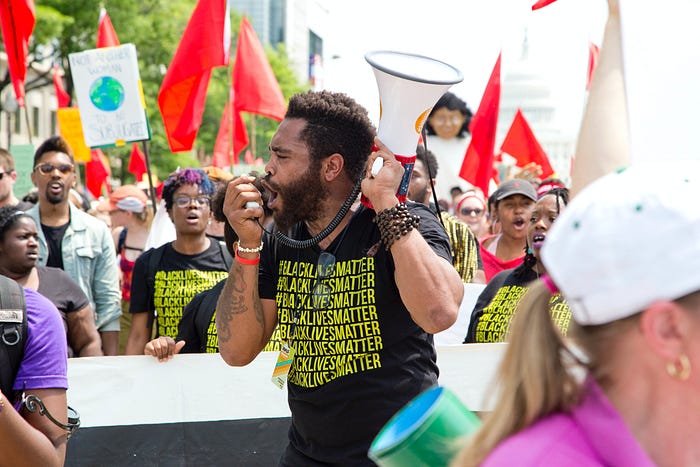“46 for 46” — 46 Ways Joe Biden Has Said He Will Use Executive Authority to Tackle Climate Change

President-Elect Joe Biden has secured a historic victory, winning the most votes of any presidential candidate in American history. His win was the culmination of a climate-driven election where voters, candidates, and the media elevated climate as a core issue for both the Biden and Trump campaigns.
Biden’s closing message centered climate change as a pressing concern for many millions of Americans. He ran television ads in at least two swing states in which he won, Arizona and Michigan, that were focused on the climate crisis. And by declaring his intention to re-enter the Paris Agreement, Biden has already continued to emphasize climate action even after all of the votes have been cast.
Biden and his running mate Vice President-Elect Kamala Harris ran on the boldest, most comprehensive climate platform ever offered by a presidential nominee. That platform, intended to be delivered through both legislative and executive actions, included calls for achieving 100% carbon-free energy in the power sector by 2035, and net-zero greenhouse gas pollution throughout the economy by 2050. It also called for investing $2 trillion in a clean energy-driven economic recovery, and directing at least 40% of that funding to the benefit of disadvantaged communities. President-Elect Biden’s demonstrated intentions to act on climate, and his electoral mandate to do so, are clear.
While composition of the U.S. Senate will be uncertain for months to come, regardless of the makeup of the Congress, Biden has already made a sweeping set of commitments to leverage executive power for bold climate action. For one, Biden’s transition team is signaling his intention to start reversing Trump’s more than 120 environmental rollbacks on Day One in office. This agenda can include replacing the ineffectual “Affordable Clean Energy” rule that gives power plants a free pass to pollute; restoring California’s authority to set its own vehicle emissions standards; reinstating the EPA rule limiting mercury pollution from coal-fired power plants; and protection public lands from barriers to fossil fuel extraction.
Even beyond overturning Trump’s deregulation, President-Elect Biden has laid out an ambitious roadmap for executive action on climate change. The following analysis of Biden’s plans highlights 46 specific ways in which the 46th President plans to reduce greenhouse gas pollution at the rate demanded by science, invest in the clean energy transition, and protect vulnerable communities from environmental harms. These 46 points come from the Biden campaign’s climate plan, the Build Back Better Plan for clean energy and infrastructure, and the Biden environmental justice plan. As president, Joe Biden will have the authority to lead the nation into a just and thriving clean energy economy for all Americans.
Below are steps to tackle the climate crisis that President-Elect Biden has already committed to take, all of which can be achieved through existing authorities and executive action:
Setting Standards to Cut Carbon Pollution

- Preserving and implementing the existing Clean Air Act, and developing rigorous new clean car standards aimed at ensuring 100% of new sales for light- and medium-duty vehicles will be electrified, and annual improvements are made for heavy-duty vehicles. And negotiating new standards with workers and their unions, environmentalists, industry, and states that achieve new ambition by integrating the most recent advances in technology.
- Requiring aggressive methane pollution limits for new and existing oil and gas operations.
- Directing the U.S. Department of Energy to redouble efforts to accelerate new efficiency standards for household appliances and equipment, which will ultimately save consumers money through new, aggressive appliance- and building-efficiency standards.
- Repairing and accelerating the building code process, and creating a new funding mechanism for states and cities to adopt strict building codes and train builders and inspectors.
- Committing that every federal infrastructure investment should reduce climate pollution, and requiring federal permitting decisions to consider the effects of greenhouse gas emissions and climate change.
- Requiring public companies to disclose climate risks and the greenhouse gas emissions in their operations and supply chains.
Investing in the Clean Energy Economy

- Develop innovative financing mechanisms that leverage private sector dollars to maximize investment in the clean energy revolution.
- Driving towards 100% clean energy and zero-emissions vehicles using the federal government procurement system, which spends $500 billion every year.
- Ensuring that all U.S. government installations, buildings, and facilities are more efficient and climate-ready while harnessing the purchasing power and supply chains to drive innovation.
- Investing in efficiency in low-income community housing through the U.S. Department of Housing and Urban Development.
- Tapping existing federal grant and loan programs at the U.S. Department of Transportation, and improving and streamlining the loan process, to help expand rail transit across America.
- Working with Amtrak and private freight rail companies to further electrify the rail system, reducing diesel fuel emissions.
- Committing to purchase clean vehicles for federal, state, tribal, postal, and local fleets, making sure that we retain the critical union jobs involved in running and maintaining these fleets.
- Directing the Secretaries of Defense and Energy to develop specific inventories of the most acute vulnerabilities in our critical infrastructure due to climate change, and prioritize upgrades, hardening, and resilience investments to mitigate them.
Working toward Environmental Justice

- Creating a date-driven Climate and Economic Justice Screening Tool to identify disadvantaged communities — including those threatened by the cumulative stresses of climate change, economic distress, racial inequality, and multi-source environmental pollution.
- Elevating and reestablishing the White House Environmental Justice Advisory Council and White House Environmental Justice Interagency Council, both reporting directly to the Chair of the White House Council on Environmental Quality (CEQ), who reports directly to the President. These two councils will be charged with revising Executive Order 12898 in order to address current and historic environmental injustice, in collaboration with local environmental justice leaders.
- Establishing an Environmental and Climate Justice Division within the U.S. Department of Justice. Directing the EPA and Justice Department to pursue criminal anti-pollution cases to the fullest extent permitted by law and, when needed, seeking additional legislation as needed to hold corporate executives personally accountable — including jail time where merited.
- Working to secure the benefits coal miners and their families have earned by establishing a Task Force on Coal and Power Plant Communities, as the Obama-Biden Administration did for Detroit when the auto industry was in turmoil.
- Immediately reinstate the annual White House Tribal Nations Conference and leverage the White House Council on Native American Affairs, which was first created in the Obama-Biden Administration.
- Overhauling the EPA External Civil Rights Compliance Office to ensure that federal grantees comply with civil rights laws and uphold environmental justice in frontline and fenceline communities
- Establishing an Interagency Climate Equity Task Force to directly work to resolve the most challenging and persistent existing pockets of climate inequity in frontline vulnerable communities and tribal nations.
- Directing the Office of Science and Technology Policy to publish a report within 100 days identifying the climate strategies and technologies that will result in the most air and water quality improvements.
- Creating a National Crisis Strategy to address climate disasters that prioritizes equitable disaster risk reduction and response.
- Leading a Task Force to Decrease Risk of Climate Change to Children, the Elderly, People with Disabilities, and the Vulnerable.
- Establishing an Office of Climate Change and Health Equity in the Office of the Secretary of Health and Human Services, and investing in surveillance, early-warning systems, and research to decrease climate change and health equity risks.
- Establishing a biennial Health Care System Readiness Task Force, a public-private task force to assess the current state of the nation’s health care system resilience to natural disasters and recommend strategies and investments to improve it.
- Ensuring the U.S. Department of Agriculture ends historical discrimination against Black farmers in federal farm programs and that all socially disadvantaged farmers and ranchers have access to programs that support their family farms.
- Recommending that each state adequately monitors environmental pollution, including emissions, criteria pollutants, and toxics, in frontline and fenceline communities.
- Recommending that every state prioritize emission reductions within disadvantaged communities identified by the Climate and Economic Justice Screening Tool in their state-level air quality plans.
- Directing the EPA to create a community notification program requiring industries producing hazardous and toxic chemicals to engage residents with real-time updates on any toxic release, and ensuring that communities are engaged in the subsequent remediation plan.
Elevating Climate Action in International Policy

- Re-entering the Paris Agreement on day one of the Biden Administration and leading a major diplomatic push to raise the ambitions of countries’ climate targets.
- Convening a climate world summit to directly engage the leaders of major carbon-emitting nations to persuade them to join the United States in making more ambitious national pledges, above and beyond the commitments they have already made.
- Instituting a new Global Climate Change Report to hold countries to account for meeting, or failing to meet, their Paris commitments and for other steps that promote or undermine global climate solutions.
- Seeking a G20 commitment to end all export finance subsidies of high-carbon projects, building on past commitments from the G7 and multilateral export finance institutions to eliminate financing for coal in all but the poorest countries.
- Conditioning future trade agreements on partners’ commitments to meet their enhanced Paris climate targets.
- Embracing the Kigali Amendment to the Montreal Protocol, adding momentum to curbing hydrofluorocarbons, an especially potent greenhouse gas that could deliver a 0.5 degree Celsius reduction in global warming by mid-century.
- Making future bilateral U.S.-China agreements on carbon mitigation — like the 2014 agreement that paved the way for the Paris accord — contingent on China eliminating unjustified export subsidies for coal and other high-emissions technologies and making verifiable progress in reducing the carbon footprint of projects connected to the Belt and Road Initiative.
- Partnering with allies to offer Belt and Road Initiative countries alternative sources of development financing for lower-carbon energy investments.
- Reforming the International Monetary Fund and regional development bank standards on debt repayment priorities for development projects. The U.S. will lead like-minded nations to establish rules that take unsustainable climate and debt costs — such as those imposed by self-interested Chinese projects — into account in prioritizing who gets paid under international debt forbearance.
- Initiate a Critical Supply Chain review immediately upon taking office, to identify critical national security risks across America’s international manufacturing supply chains — including for energy and grid resilience technologies.
- Commissioning a National Intelligence Estimate on national and economic security impacts from climate change, including water scarcity, increased risks of conflict, impacts on state fragility, and the security implications of resulting large-scale migrations
- Directing the Secretary of Defense and Chairman of the Joint Chiefs of Staff to report to him annually on the impacts of climate change on defense posture, readiness, infrastructure, and threat picture, as well as the Defense Department’s strategy to manage those impacts.
- Directing the National Security Advisor, working with the Secretaries of Defense, State, Homeland Security, and others, to develop a comprehensive strategy to address the security implications of climate change.
Focusing on Conservation

- Banning new oil and gas leasing on public lands and waters, and modifying royalties to account for climate costs. Also developing renewables on federal lands and waters with the goal of doubling offshore wind by 2030.
- Protecting biodiversity by conserving 30% of America’s lands and waters by 2030 — to slow extinction rates and helping leverage natural climate solutions
- Protecting America’s natural treasures by permanently protecting the Arctic National Wildlife Refuge and other areas impacted by President Trump’s attack on federal lands and waters, establishing national parks and monuments that reflect America’s natural heritage, and establishing targeted programs to enhance reforestation.
